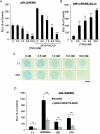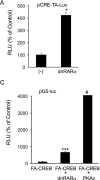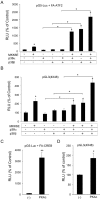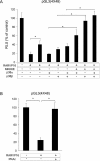Requirement for RAR-mediated gene repression in skeletal progenitor differentiation
- PMID: 12105181
- PMCID: PMC2173026
- DOI: 10.1083/jcb.200112029
Requirement for RAR-mediated gene repression in skeletal progenitor differentiation
Abstract
Chondrogenesis is a multistep process culminating in the establishment of a precisely patterned template for bone formation. Previously, we identified a loss in retinoid receptor-mediated signaling as being necessary and sufficient for expression of the chondroblast phenotype (Weston et al., 2000. J. Cell Biol. 148:679-690). Here we demonstrate a close association between retinoic acid receptor (RAR) activity and the transcriptional activity of Sox9, a transcription factor required for cartilage formation. Specifically, inhibition of RAR-mediated signaling in primary cultures of mouse limb mesenchyme results in increased Sox9 expression and activity. This induction is attenuated by the histone deacetylase inhibitor, trichostatin A, and by coexpression of a dominant negative nuclear receptor corepressor-1, indicating an unexpected requirement for RAR-mediated repression in skeletal progenitor differentiation. Inhibition of RAR activity results in activation of the p38 mitogen-activated protein kinase (MAPK) and protein kinase A (PKA) pathways, indicating their potential role in the regulation of chondrogenesis by RAR repression. Accordingly, activation of RAR signaling, which attenuates differentiation, can be rescued by activation of p38 MAPK or PKA. In summary, these findings demonstrate a novel role for active RAR-mediated gene repression in chondrogenesis and establish a hierarchical network whereby RAR-mediated signaling functions upstream of the p38 MAPK and PKA signaling pathways to regulate emergence of the chondroblast phenotype.
Figures











Similar articles
-
Molecular mechanisms regulating chondroblast differentiation.J Bone Joint Surg Am. 2003;85-A Suppl 2:124-32. doi: 10.2106/00004623-200300002-00017. J Bone Joint Surg Am. 2003. PMID: 12721355 Review.
-
p38 MAP kinase regulation of AP-2 binding in TGF-beta1-stimulated chondrogenesis of human trabecular bone-derived cells.Ann N Y Acad Sci. 2002 Jun;961:172-7. doi: 10.1111/j.1749-6632.2002.tb03077.x. Ann N Y Acad Sci. 2002. PMID: 12081893
-
Requirement of the p38 mitogen-activated protein kinase signalling pathway for the induction of the 78 kDa glucose-regulated protein/immunoglobulin heavy-chain binding protein by azetidine stress: activating transcription factor 6 as a target for stress-induced phosphorylation.Biochem J. 2002 Sep 15;366(Pt 3):787-95. doi: 10.1042/BJ20011802. Biochem J. 2002. PMID: 12076252 Free PMC article.
-
Interleukin 1alpha (IL-1alpha) induced activation of p38 mitogen-activated protein kinase inhibits glucocorticoid receptor function.Mol Psychiatry. 2004 Jan;9(1):65-75. doi: 10.1038/sj.mp.4001339. Mol Psychiatry. 2004. PMID: 14699442
-
Retinoid signalling and skeletal development.Novartis Found Symp. 2001;232:171-85; discussion 185-8. doi: 10.1002/0470846658.ch12. Novartis Found Symp. 2001. PMID: 11277079 Review.
Cited by
-
Palovarotene Action Against Heterotopic Ossification Includes a Reduction of Local Participating Activin A-Expressing Cell Populations.JBMR Plus. 2023 Oct 19;7(12):e10821. doi: 10.1002/jbm4.10821. eCollection 2023 Dec. JBMR Plus. 2023. PMID: 38130748 Free PMC article.
-
Tenogenic Induction From Induced Pluripotent Stem Cells Unveils the Trajectory Towards Tenocyte Differentiation.Front Cell Dev Biol. 2022 Mar 9;10:780038. doi: 10.3389/fcell.2022.780038. eCollection 2022. Front Cell Dev Biol. 2022. PMID: 35372337 Free PMC article.
-
Hereditary Multiple Exostoses-A Review of the Molecular Background, Diagnostics, and Potential Therapeutic Strategies.Front Genet. 2021 Dec 10;12:759129. doi: 10.3389/fgene.2021.759129. eCollection 2021. Front Genet. 2021. PMID: 34956317 Free PMC article. Review.
-
Retinoic acid actions through mammalian nuclear receptors.Chem Rev. 2014 Jan 8;114(1):233-54. doi: 10.1021/cr400161b. Epub 2013 Dec 5. Chem Rev. 2014. PMID: 24308533 Free PMC article. Review. No abstract available.
-
Acquired and congenital forms of heterotopic ossification: new pathogenic insights and therapeutic opportunities.Curr Opin Pharmacol. 2018 Jun;40:51-58. doi: 10.1016/j.coph.2018.03.007. Epub 2018 Mar 31. Curr Opin Pharmacol. 2018. PMID: 29614433 Free PMC article. Review.
References
-
- Bell, D.M., K.K. Leung, S.C. Wheatley, L.J. Ng, S. Zhou, K.W. Ling, M.H. Sham, P. Koopman, P.P. Tam, and K.S. Cheah. 1997. SOX9 directly regulates the type-II collagen gene. Nat. Genet. 16:174–178. - PubMed
-
- Bi, W., J.M. Deng, Z. Zhang, R.R. Behringer, and B. de Crombrugghe. 1999. Sox9 is required for cartilage formation. Nat. Genet. 22:85–89. - PubMed
Publication types
MeSH terms
Substances
LinkOut - more resources
Full Text Sources
Other Literature Sources
Molecular Biology Databases
Research Materials

